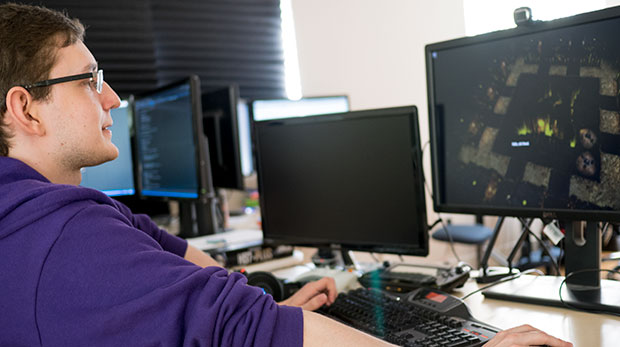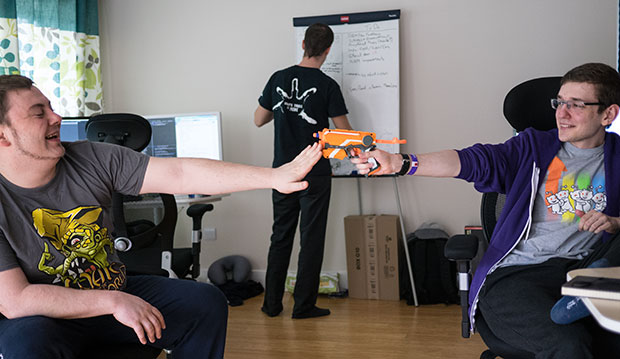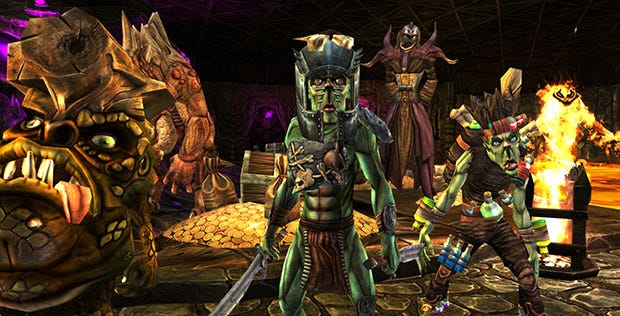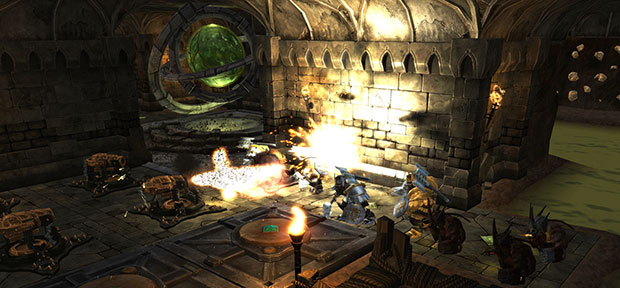How To Remake Dungeon Keeper
The Making Of War For The Overworld
War for the Overworld [official site] creative director Josh Bishop uses the word ‘ridiculous’ quite a bit. It’s understandable. The 22-year-old is on the verge of releasing what is intended to be the first faithful follow-up to beloved strategy/management/Imp-slapping title Dungeon Keeper in 16 years. He leads a studio which has reached as many as 20 members, he’s received £200,000 in Kickstarter pledges, he’s had Peter Molyneux’s blessing and an implicit agreement that rightsholder EA would look the other way, he's got original narrator Richard Ridings onboard and tomorrow, all being well, it all comes to fruition. “It’s ridiculous.”
Young, thin, bespectacled, dressed in a Reddit t-shirt with a now-month-old Rezzed wristband and a first edition Pebble watch on one wrist, his manner quietly confident but without evident arrogance, the Brighton, UK resident is about as far a cry from my mental image of the executives who decide the fate of the official Dungeon Keeper as it’s possible to get. While he and Subterranean Games’ impending unofficial remake/sequel War for the Overworld is very much a job, it’s also the culmination of a passion project almost a decade in the making.
“The entire existence of the team and the project formulated on a Dungeon Keeper fansite,” he tells me in the cavernous kitchen of the enormous Brighton house which seven Subterranean staff (and a few partners) now both live and work in. Booze, pizza and boardgames abound, there are a host of powerful-looking PCs on the downstairs floor, and it’s a place I’d give my right arm to live in, but at the same time I can see how its being a workplace is preventing it from being a home too. I have little doubt that, even this many years on, the game that Bishop once referred to as ‘Dungeon Keeper 3’ remains this team’s life.
“People were initially talking about it six, seven years ago on this site, and it’s just slowly, slowly grown since then,” Bishop explains. Their impetus was simple but clear: “We just wanted a new Dungeon Keeper game.” It took a while to truly get going, as most people were young and inexperienced, and the tools which power so many of today’s smaller games just weren’t ready yet – let alone the new funding models which could make ideas a reality without needing publisher backing. “To say we had much idea of what we were doing back when we started would be a bit of a lie,” admits Bishop. “We were incredibly inexperienced, now we’re a little bit inexperienced.”

Josh Bishop, CEO and Creative Director at Subterranean Games, playtests the penultimate level of War For The Overworld's campaign.
Although the various participants created “this massive mountain of ideas” over three or four years of online collaboration, it wasn’t really going anywhere. “It was sort of a disorganised collective of people wanting to do things for a while. There was random people making character models or concept art, bits of prototypes. There was no structure to anything.”
The years passed by with plenty of ideas put to paper and the team “knowing what we were going to copy and what we were going to do new”, but it wasn’t until 2012 that what would be War for the Overworld truly became a going concern. “We thought let’s try and get realistic and put something together properly. So we put a more structured team together and we worked a bit on the Unreal prototype, but UDK at the time did not suit this kind of thing. Then we picked up Unity and started working on it again, and we were pretty happy with what we were ending up with, and more and more people who seemed like a good fit were joining the project. Then towards the end of 2012 I went and set up the company officially, and we did the Kickstarter. And that went well.” It did, to the tune of £211,371. Not bad for a game which didn't have a famous name and didn't have any of the original staff onboard.
For the next two and half a years – long past the originally promised Summer 2013 release date – Subterranean worked from bedrooms across the globe. With cash in hand the team fluctuated between 15 and 20, including staff in Australia, Hong Kong and Russia, but that still wasn’t enough to take them anywhere close to their intended deadline. “We had some people on the team at that point who were not the best people to have on the team. Specifically those were the people who had put stuff on the Kickstarter like ‘we’re going to be done with game in August 2013’ and at that point in time there were some of us questioning that, but we thought these people were more experienced than us so we’ll let them say that. So that was obviously completely ridiculous.”
Around a month ago, seven staff – including contributors from Germany, France and Australia – moved into this Sussex mini-palace, and now they’re spending every moment they can tweaking right up until release. “The remote working wasn’t working out for little bits of polish and rapid bug-fixing, it just wasn’t working.”

Subterranean Games near-subterranean studio, on the lowest floor of an impressive Sussex house in which seven of the staff also live.
What’s remarkable is how much has worked, given what a long shot such an unofficial endeavour was. Kickstarter ennui had barely settled in back in late 2012, their plans for an open beta on Steam coincided with Valve’s launch of Early Access in 2013, and Unity was steadily blossoming into the go-to tool it is today. What if Subterranean had only gotten into gear a year later? “It would have been a completely different story.”
Added to that is a miraculous-seeming near-total lack of obstacles from Dungeon Keeper’s creators and gatekeepers. Original Dungeon Keeper creative lead Peter Molyneux endorsed the project’s Kickstarter after Bishop contrived a chance encounter at the first Rezzed expo. “He gave a talk about Curiosity. I went deliberately and sat in the front row, near the exit, so that I the end I could go and pounce on him and say ‘hey Peter, we’re doing this, can you give us a hand?’” The video which eventually resulted from this – just weeks after Molyneux and 22 Cans’ own Kickstarter for the controversial Godus - was a big help to Subterranean’s campaign. “To this day, people still link that video in response to anyone saying ‘why are you guys copying Dungeon Keeper?’ That’s a really useful card to have.”
As gracious as this was, neither Molyneux or anyone else at original Dungeon Keeper developer Bullfrog Productions could have any say in its future. The rights belonged to publisher EA, who’d all but ignored the once best-selling series for almost 15 years. Until 2012. EA Mythic’s Paul Barnett (a name which will ring a bell or six for older readers) got in touch with Bishop around the time of the Kickstarter, and arranged a video call. “Then he just held up this iPad and said ‘we’re making this.’”
‘This’ was Dungeon Keeper, a mobile game released for iPhone and Android in 2013. It took the original Dungeon Keepers’ theme and characters then applied them to a free to play game which deviated significantly from the original mechanics, and in which progress was gated by either long wait times or in-app purchases. Dungeon Keeper fans loathed it, creating a large internet outcry, and to make matters worse for EA the UK Advertising Standards Agency deemed that adverts which described the game as ‘free’ misrepresented it.
Josh Bishop, perhaps sensibly, won’t be drawn either into savaging the mobile game or celebrating its failure, but he acknowledges that it may have been helpful. “A lot of articles which spoke about Dungeon Keeper, a lot of videos which spoke about Dungeon Keeper said ‘hey, you should go and check out War for the Overworld’. It was beneficial to us in that regard.”
While not actually defending it, he points out that Dungeon Keeper mobile’s model was very similar to a great many other mobile games of the time, which followed the Clash of Clans model, and feels this one caught more flak purely due to expectations. “Most of the people who like Dungeon Keeper have not been exposed to that sort of game. Because it was called Dungeon Keeper they went and looked, and their first experience of this monetisation model is what they see as a bastardisation of their childhood. Which I guess is an understandable reaction, and because of that a lot of attention was pointed towards us.”
Back before all this, however, there was Paul Barnett and that video call. How was EA going to take to an unofficial sequel when they were on the verge of an official one? “His only concern at that point was just making sure that we weren’t backed by Ubisoft or some other big publisher. He just wanted to make sure that we were fans of the genre making it. As soon as he realised that was the case he said that was fine, and that he was going to ensure EA corporate left us alone.”
On page two: what features they had to cut, where it differs from its source material, plus multiplayer and post-release plans.
Another lucky break, though it wasn’t a greenlight to take whatever they wanted. “He asked that we didn’t deliberately copy characters from their game. Like ‘don’t have a big, red, horned demon.’ We weren’t going to do that anyway, we’re not dumb. We did say that if there’s anything specific that’s a problem just let us know, and they haven’t said anything.” Fingers crossed that’s still the case tomorrow, eh?
With these hurdles jumped, all that remained was the little matter of actually making the game. The August 2013 date came and went. “We weren’t as organised as we should have been back then. That’s happened. We got a lot better at that in early 2014. We really hit our stride.” Bishop attributes some of the lost time to an attempt at including modding support. “It turned out to be impossible for our skill and production Working on that probably cost us six to eight months of development time, which was a big pain.” In the end, they dropped it, but it wasn’t the only area in which Subterranean had eyes bigger than their stomachs.
“We woefully underestimated certain things. A couple of things were easier than they thought they would be, but for the most part it’s been harder than we thought it would be.” Almost everything was made from scratch, bar a few Unity plugins such as one which renders the UI with HTML and another which helps with networking. Art and sound are all their own. “It’s a ridiculous number of assets.”
One of the biggest stumbling blocks turned out to be a save/load system. Bread and butter for most any PC game, but a serious headache for War for the Overworld. “We got it working, then every single change we made to the game broke it, and it was like urgh. Eventually we decided that we’re not officially supporting it until launch date. Even in the current live build on Steam there is no saving and loading. We’ve now got it so whenever we change something we’re going and testing saving and loading and it’s ok, but to do that for eight months would have been a complete, ridiculous waste of time.” That word again.

Studio in-jokes about Overworld's oft-torturous progress
So why put all this sweat, all this ridiculousness, into remaking an existing game rather than making their own one entirely? “I wanted to get into the games industry and this is something I very much wanted to happen. A lot of people wanted it to happen but no-one was lighting a fire to actually bring it all together.” Bishop cites Dungeon Keeper’s enduring appeal as a combination of playing as the bad guy, units with semi-free will and the grid-based, sandboxy room building. “Other games have stuff like it, something like Theme Hospital, you do build your rooms like that but then you go and place everything inside the room. Very few games have it like this, where you literally just section it off and the props are built and that’s that, and then your units come in and do stuff. It’s just nice. The room-building and the territory-management in general, it’s something that’s very unique. It’s the very core of the game really.”
However, Bishop and his team weren’t mega-fans to the point of believing either existent Dungeon Keeper was perfect as-was. They’ve made changes - some of which they devised many years ago – and not everyone’s happy about it. “There are people who say ‘why isn’t the Mistress a scantily-clad woman?’ Why is there no Horned Reaper in your game? Why is mana different, why do doors work like they do? There are people who don’t want any changes to be made to the game. If you don’t want any changes then just go play Dungeon Keeper 2.”
The lesser-loved sequel is, however, the main inspiration for War for the Overworld. “A lot of people disagree but in my opinion 2 was a much more complete game than the first one was, but it obviously had big flaws. The biggest flaws, from a game design perspective, was the general lack of pacing and choice in the game, especially when it came to multiplayer.”
Personally, I’m the sort of Dungeon Keeper fan who loved it as a private sandbox, the quiet joy of construction within the architectural limitations of an underground space, but Bishop’s primary interest is multiplayer, which DK2 is better set up for. If I’d ever wondered if this was a cynical cash-in of a project, that fear is put to rest as I watch him play War for the Overworld. His hands, and the contents of the screen, move with what seems to me like the dizzying speed of a StarCraft II pro. There’s a mastery of the game and its interface that I’d never even realised was possible in my unhurried solo play, something clearly borne of years spent continuing to play a game long ago abandoned by its owners.
I do have some concerns, based on playing a few levels of the campaign, that this multiplayer-focused thinking has been a little detrimental to the solo side of the new game. The mouse interface feels fiddly, the camera doesn’t pull far enough out to take it all in, the minimap isn’t particularly helpful and in general it feels like it’s been made for people who know exactly what they’re doing every second of the time and can bring about any effect or construction with barely a glance at the UI. Whenever Bishop mentions a change or new feature, it’s in terms of its effect on multiplayer. But I wonder if I’m being a purist: whatever I might say outwardly about novelty and creativity, if I sit down to play a game like Dungeon Keeper there’s a big part of me which yearns for it to be my Dungeon Keeper, exactly that which I loved in the 1990s.
Perhaps I’ll become more a convert once I’m further in and I’ve adapted to an ethos that’s perceptibly more about fluidity than linearity in both single and multiplayer. Certainly, it's got the key beats of DK in place; there's an essential and comforting familiarity, an atmosphere defined by the sound of lonely slave-creatures painstakingly chipping away at sheer stone walls, but at the same time there are things in the menus I don't recognise, which are the result at attempts to address Bishop’s key criticism of DK2. “You went in and you had everything except all your spells, which you got given in a linear order. Basically there was one winning strategy, which was get a combat pit, get Dark Knights and level your Dark Knights up and then go and kill the enemy. And that was all you could do.”
With this in mind there’s an overhauled mana system which prevents any one player from becoming a magical god once the enemy’s on their territory, doors which prevent both foe and friend from passing through if locked, and a non-linear research system which effectively sees you making a tech tree of your own rather than climbing a fixed ladder. “One of the big driving desires with this was to bring some level of strategy and choice and pacing into all modes. That was one of the biggest things which was lacking.”
Tomorrow, Subterranean will finally discover whether they’ve made the game that Dungeon Keeper fans have been waiting for, but the work won’t end there. They’re very conscious that it’s launching with bugs, and sorely wish to have had a few more weeks before the release date they’d agreed with Steam, but hope that in today’s development climate they won’t be torn to pieces for it. “We could have done with more time, but I think the industry as a whole has evolved to appreciate quick fixes after launch, I guess. Especially if they realise how inexperienced we are.”
That inexperience is why this game exists at all, of course. An established studio would never have attempted a fan remake of a game owned by another firm. I wonder whether the long, ridiculous road to War For The Underworld has turned Subterranean off Dungeon Keeper, and off the concept of remaking games themselves. “The bit I’m a bit sick of is the campaign, because of how much we have now all played it. Ridiculously. That got a bit stale, but there are some levels which are still really fun to play, because they’re organic in nature, it’s not a set do this, do that, do this.”

In the absence of demonic hand with which to slap him, Bishop shows programmer Stefan Furcht how he feels about OTT difficulty in a later level of the game
He’s far more keen on Skirmish mode, which includes an AI difficulty setting named Stephen Fright, which he feels is ‘impossible’, and a Survival mode planned for post-release. “We’re going to have mutators and regular sets of challenges so you can set up different waves, there’ll be a leaderboard and whatever. That, in my opinion, is probably going to end up being the most fun part of the game, but we haven’t had time to get to it properly yet, unfortunately.”
But first, patches. And after Survival, story DLC, which will be free to ‘early adopters’ who bought the game at or not long after release, and which will star a character encountered during the main campaign rather than its primary protagonist. After that? A new game, and they’re not ruling out another remake. “We wouldn’t mind being known for doing that well, but that’s not all we want to do. That might be what we do next though. Maybe once more. But we’ll see.”
We’ll know very soon whether War For The Overworld has gotten everything right, but what we’re looking at is a fan remake that’s morphed into commercial remake, and made it all the way to the finish line. That in itself is a hell of an achievement. It’s been a long road, but Subterranean treading it again sometime doesn’t seem ridiculous at all.
War for the Overworld [official site] is on Early Access now, and has a full release tomorrow.








